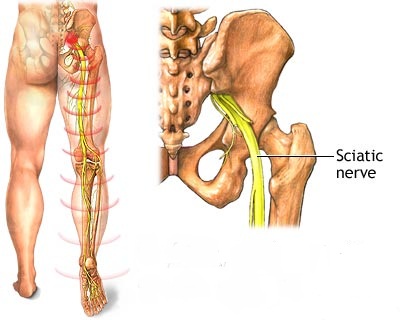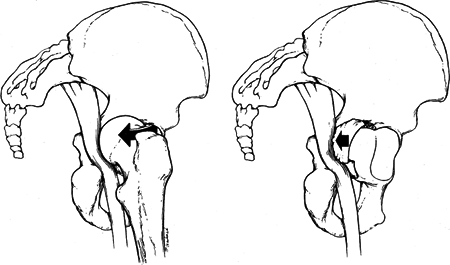Sciatic Neuropathy
February 13, 2013 Neurology Update
A neurology education blog from Dr Holland and The Monmouth Neuroscience Institute
The terms lumbar radiculopathy and sciatica are used interchangeably to indicate radiating pain, numbness and weakness in a leg from a pinched nerve root in the back.
However, it is important to recognize that similar symptoms and signs can be caused by injury or compression of the sciatic nerve outside the spine, either in the buttock or thigh.
The sciatic nerve is the longest and widest nerve in the body, extending from the spine all the way to the foot, and contributes most of the nerve supply to the leg:

Sciatic nerve injury presents with:
1. Numbness affecting the entire leg, aside from the front of the thigh.
2. Weakness of the hamstrings, and all movement at the ankle.
3. Absent ankle jerk.
Sciatic Nerve Injury in the Buttock:
The nerve can be injured by misplaced buttock injections, gunshot wounds and knife injury. Buttock injections should be given in the upper outer quadrant to avoid the sciatic nerve

The sciatic nerve injury can also be injured by prolonged sitting on a toilet seat, either from direct nerve compression or hemorrhage and compartment syndrome into the gluteal muscles. This has been reported in cases of severe prolonged diarrhea, or drug induced coma on the toilet, so called toilet seat neuropathy.

Sciatic Nerve Injury at the Hip:
The sciatic nerve runs behind the hip joint as it travels through the buttock.
The sciatic nerve is frequently injured by a posterior dislocation of the hip:

Sciatic nerve injury occurs in as many as 1%–3% of patients who undergo total hip replacement surgery, usually from a stretch injury to the nerves, but occasionally from a misplaced crew, broken piece of wire, fragment of bone or cement pressing on the nerve:

Sciatic nerve injury after hip arthroplasty. (a) The skin incision for the transgluteal approach is in a continuous line. The cross on the left shows the ischium and the one on the right shows the trochanter. Between them, the skin projection of the sciatic nerve is seen. (b) The sciatic nerve was freed from all attachments. The arrows identify acrylic material from the hip arthroplasty, which was damaging the nerve
Piriformis Syndrome:
However, symptoms of sciatic neuropathy most often result from nerve compression by the piriformis muscle at the level of the sciatic notch, so-called piriformis syndrome.

This presents with buttock tenderness and pain, radiate down the posterior thigh. Symptoms are made worse by prolonged sitting, bending at the waist, and activities involving hip adduction and internal rotation. The pain can be reproduced by deep palpation over the sciatic notch.
Diagnostic modalities such as CT, MRI, ultrasound, and EMG may all be normal in piriformis syndrome, but are still useful for excluding other conditions.
Magnetic resonance neurography is a specialized imaging technique which can confirm the presence of sciatic nerve irritation or injury of the sciatic nerve in the piriformis muscle.

MRN findings in piriformis syndrome. A: Axial T1-weighted image of piriformis muscle size asymmetry (arrows indicate piriformis muscles). The left muscle is enlarged. B and C: Coronal and axial images of the pelvis (arrows indicate sciatic nerves). The left nerve exhibited hyperintensity. D: Curved reformatted neurography image demonstrating left sciatic nerve hyperintensity and loss of fascicular detail at the sciatic notch (arrows).
Conservative treatment can include medications, physical therapy and stretching, or injection of a paralysing agent such as botulinum toxin into the piriformis muscle under ultrasound or CT control. Surgery may be necessary for recalcitrant cases.
http://mmcneuro.wordpress.com/2013/02/13/sciatic-neuropathy/

No comments:
Post a Comment
All comments welcome but advertising your own service or product will unfortunately result in your comment not being published.